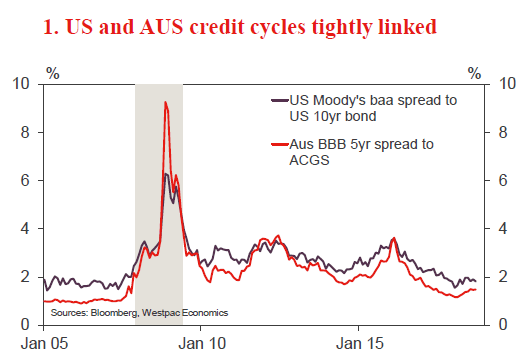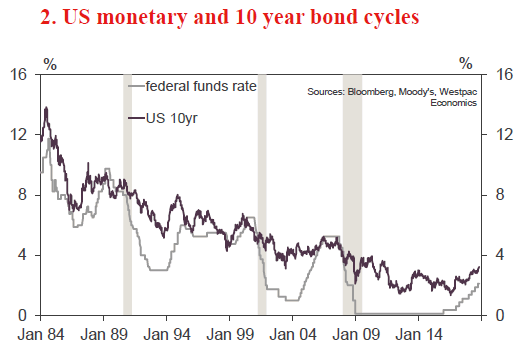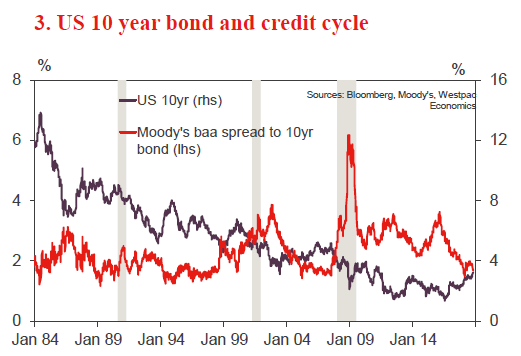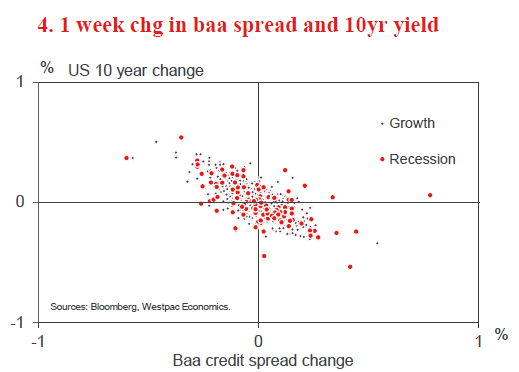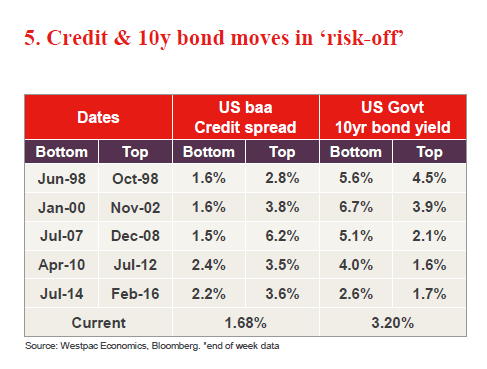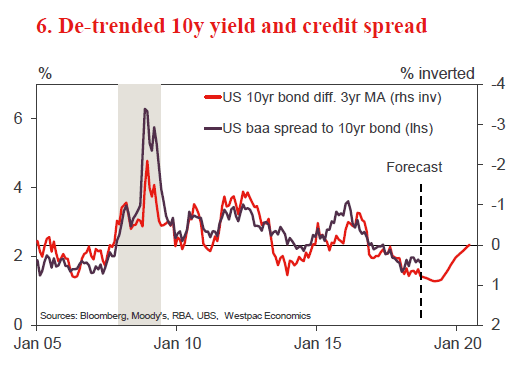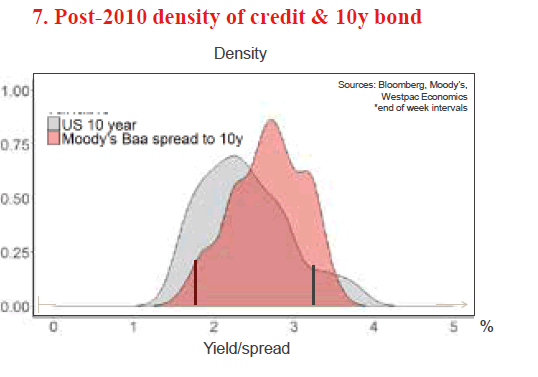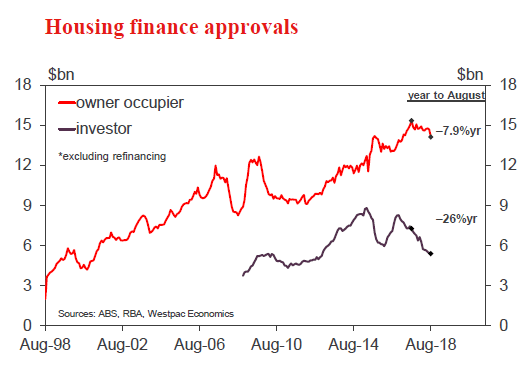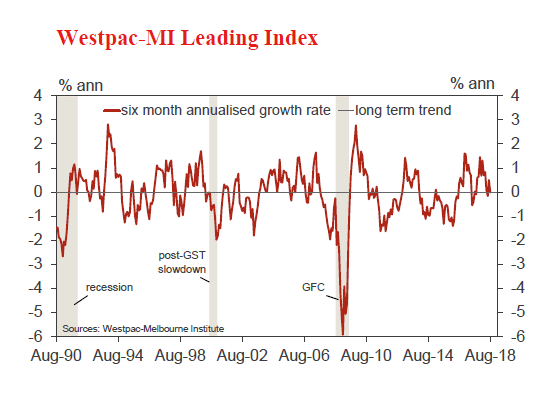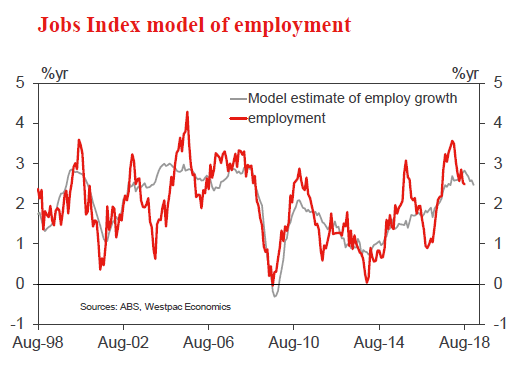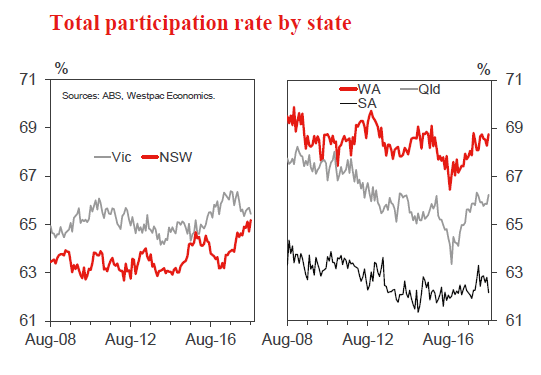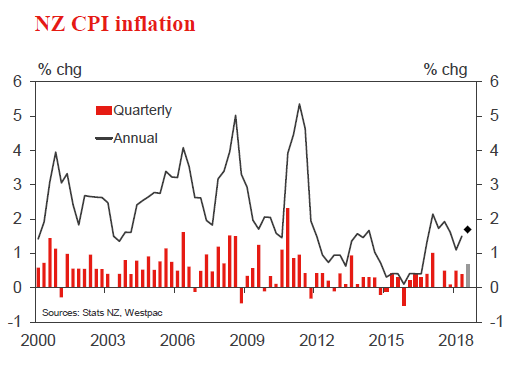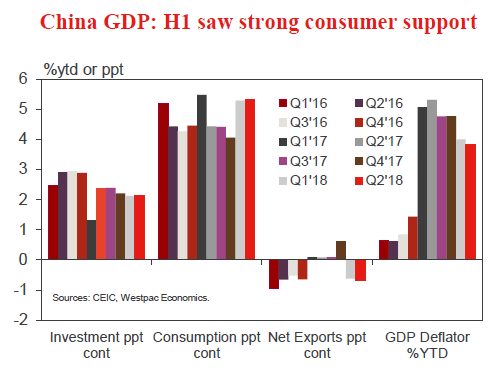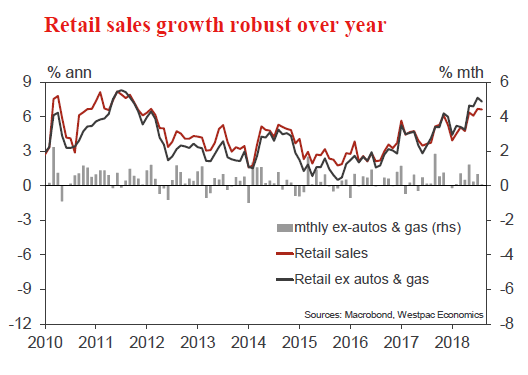Week beginning 15 October 2018
- Credit spreads and monetary policy cycles.
- RBA: minutes, RBA Deputy Governor Debelle speaks.
- Australia: Westpac-MI Leading Index, employment,
- NZ: CPI.
- China: GDP, new loans.
- Europe: EU Summit.
- US: FOMC meeting minutes, retail sales.
- Other central banks: BoK policy decision, BoE Carney speaks, BOJ Kuroda speaks.
- Key economic & financial forecasts.
Information contained in this report current as at 12 October 2018.
Credit Spreads and Monetary Policy Cycles
Though credit spreads in the US are off their lows, they have remained relatively impervious to the heightening global risks surrounding trade and geopolitics. This partly reflects the strength in the US economy which has continued to support corporate earnings. With credit spreads in the US and Australia tightly linked, our spreads have also held at a low level.
As the Fed continues to push the federal funds rate higher, we are approaching the ‘neutral’ policy rate and therefore nearer the top of the cycle. It is rare policy remains at its plateau for a sustained period, and so it is not premature to start considering a turning point in the current expansion.
In assessing the risks, this piece will examine the historic dynamic between the US 10 year bond yield and credit spreads and questions why the relationship may be different in the current cycle. As Australian credit spread indexes only date back just over ten years, this analysis uses Moody’s Baa index as a proxy for general credit spreads*. While it references longer dated assets than the US 10 year, and comprises of US assets rather than Australian, chart 1 shows that it is a suitable substitute data series for the Australian 5y BBB index for the purposes of assessing cyclical trends.
In the post-stagflation era, credit spreads and the 10 year bond have shown a close negative relationship. Credit spreads typically lift from their bottom at around the same time the 10 year bond yield falls from its cyclical peak. As such, fixed rate corporate credit often tends to be in part naturally hedged with movements in the credit spread offset to varying degrees by movements in the ‘risk-free’ component.
A clear feature of chart 3 is the downward structural trend in the US 10 year yield as opposed to stationarity in the credit spread which has shown a firm support around 1.5% over the past three and half decades. On the other hand, the 10 year yield has moved lower on the back of the structurally lower federal funds rate and associated lower ‘neutral rate’. Therefore a clearer way to visualise the relationship between credit spreads and the 10 year bond is to look at the change in rates rather than the outright level. Chart 4 shows the weekly change in the US 10 year bond yield and the Baa credit spread from 1998.
There appears to be a fairly consistent negative relationship in times where the economy is expanding. But note the cluster of outliers to the right of the chart which emphasise the potential for outsized widening in credit spreads relative to the fall in bond rates during a credit crunch such as the GFC. Also, the extent that the purple dots (reflecting non-recessionary periods) are scattered shows that the bond rate and spreads can experience smaller financial cycles within the broader overarching economic cycle. The table overleaf shows the trough and peak of recent ‘risk-off moves’ in credit spreads and the coinciding move in the 10 year bond rate over the period.
In the ‘risk-off’ periods up to the GFC, the moves in credit spreads have generally approximated the moves in bond rates. However, the GFC saw an exceptionally large widening in credit spreads, well in excess of the decline in the bond rate over the period, which emphasises the potential for non-linear reactions.
The latest example through 2014-16 when a more moderate widening in spreads was met by a lesser decline in the bond rate bears of most interest for what may be ahead of us.
From July 2014 to February 2016, the Baa spread rose by around 1.4% whereas the bond rate fell by only 0.9%. Notable in this cycle was the starting rate of the bond rate which was much lower than that of previous ones – 2.6% compared to 4-7%. With the neutral federal funds rate having structurally trended closer to the lower bound, there is less room for bond rates to fall in an economic downturn. Consequently, the relationship between credit spreads and the US 10 year bond yield is likely to become increasingly non-linear even in less severe ‘risk-off’ environments.
To illustrate the above point, chart 6 looks at the Baa credit spread and the 10 year bond yield de-trended by taking the difference between the actual rate and its trailing three year moving average. The relationship has been very tight over the last thirteen years but there are two notable exceptions. The first was mentioned before, the 2014-16 period, and the second was the taper tantrum in 2013 where bond yields rose but credit spreads were relatively stable. It is likely that in the latter, higher bond yields were driven by flow effects (or expectation of flow effects) rather than strength in fundamentals which would typically see lower credit spreads. That has important implications for today’s environment given that the Fed is still quantitative tightening.
Conclusion
Our base case forecast for the US 10 year bond rate is a rise in the short-term to 3.5% in June 2019 followed by a decline back to 2.8% in December 2020 as the Fed stops hiking. Based on the historical negative relationship, this would see general credit spreads reach their lows by June 2019 and then start to widen from thereon.
It is important to note that our anticipated retracement of the US 10 year yield is quite shallow and is conditioned on a softlanding for the US economy. That then would be associated with only a moderate rise in credit spreads.
If a worse scenario were to take place and credit spreads were to widen more significantly, it is likely that the protection from a coinciding decline in the US 10 year bond yield would be more muted than in past crises. This is because we are closer to the lower bound in interest rates and there is less room for the 10 year to fall. On the other hand, credit spread widening is far off any potential limits to the upside.
Nevertheless, we consider the risks to the timing of our outlook are skewed to the upside. An extension of the hikes into the second half of 2019 would imply a lengthening of the current expansion and allow greater room for the 10 year to fall.
A second word of caution relates to the scope of this analysis. The history is deliberately chosen from the post-stagflation era. The unlikely (albeit still possible) return of stagflation would see higher and more uncertain inflation expectations, higher bond yields and higher credit spreads.
The week that was
It has been a tumultuous week for the global economy, with higher US term interest rates; fears over global growth; and some ill-considered words from President Trump resulting in a dramatic sell-off for global equity markets. Brexit negotiations are ongoing, with positive rumours but little fact. Ahead of next week’s European Council Summit, angst over Italy’s budget also lingered. Back in Australia, abstracting from market tremors, businesses remain in a strong position, but consumers are circumspect over housing and spending.
Albeit underpinned by strength in the US economy, last week’s rise in the US 10yr yield to its highest level in seven years at 3.25% clearly unnerved investors across the world. Higher interest rates in the US combined with a higher currency are tightening financial conditions and creating a headwind for US growth into 2019. This is not only of significance for the US. Investors are also clearly concerned over the effect higher US interest rates and reduced US dollar liquidity will have on emerging markets, particularly as the US/ China tariffs come into full effect; Turkey and Argentina’s woes persist; and a number of emerging Asian nations have to increase policy rates further to offset potential inflation shocks from the dramatic currency depreciations experienced over the past year.
These are all legitimate concerns and reason for a reversal of some of global markets’ recent gains. But arguably the veracity of the declines (now almost 8% for the S&P500 from the latest peak) has as much to do with remarks by President Trump. Late on Wednesday and Thursday, President Trump labelled the Fed as “out of control”; “ridiculous”; and “loco” given their recent decision to raise interest rates for a third time in 2018 and guidance that further rate hikes will be seen through 2019 and into 2020. Thursday’s “they’re making a big mistake” subsequently amplified concerns, being a stark contrast to the optimism and confidence that Chair Powell and the FOMC have been communicating in recent months.
We at Westpac continue to hold that 2.875% is more likely to be the peak in the federal funds rate – 50bps below the FOMC’s own median forecast. Our lower end point is a consequence of the continued absence of a wage/ inflation threat and a belief that GDP growth in the US will slow back to trend at the end of 2019 – where it will remain thereafter. The past 7 days have supported this view. While the September US employment report was another blockbuster in terms of job creation, hourly wages growth remained modest. The September CPI report subsequently disappointed, with headline and core inflation coming in at just 0.1%. For the latter, while one-off negatives held down inflation in September, there was no real evidence of underlying inflation pressures building in the detail. Looking ahead, US inflation will run higher on the back of rising tariffs; higher energy costs; and replacement spending after hurricane season, but these are also one-offs which the FOMC will look through. The FOMC will only follow through with rate hikes past our forecast of 2.875% if the underlying strength of the economy (activity; wages and inflation) warrant it. On the economics of the situation, there is therefore cause to be broadly sanguine on the outlook for markets. Politics however will remain a source of material uncertainty.
Coming back to Australia, there have been two key releases this week: the NAB business survey; and our own Westpac–MI consumer sentiment survey.
For business, both conditions and confidence rose in September, signalling a stabilisation after the first half’s deceleration and the political shock to confidence that came from the Liberal leadership spill in August. At current levels, confidence is around average, and conditions well above. While forward orders and investment intentions both fell in the month, broadly they are still positive for the outlook. Employment intentions are also constructive for growth, remaining at an elevated level. The industry breakdown continues to show mining, construction and business services as the stand-out sectors. Retail in contrast continues to lag, though momentum for recreational and personal services is promising.
Australian consumers are also positive on the economy, with views on the one and five-year outlook above average. That said, though this confidence has translated through to optimism over the labour market, family finance expectations remain subpar. This is particularly the case for the year-ahead view, which is about 5% below average. This disconnect is, in part, due to persistent weakness in wages growth, but also the ongoing housing market deterioration. Price declines are continuing, and our sentiment survey suggests there is further declines to come, with house price expectations 20% below average overall and Sydney and Melbourne particularly weak. Understandably, ‘time to buy a house’ and ‘a major household item’ are respectively 14% and 6% below average. The latter highlights the significance of price declines and higher interest rates not only for housing construction, but also for consumption.
Chart of the week: Australian housing finance
Australian housing finance approvals continued to soften in August. The headline number of owner occupier loans fell 2.1%, -10.2%yr, and excluding refinancing, the decline amounted to 2.9%, 13.9%yr. The value of investor loans were also lower, down 1.1% to be 20.5% lower over the past year to August (an estimated -26% excluding refinancing).
The total value of housing finance approvals including investors but excluding owner occupier refi, fell 2.7% in August and is down 13.6% in annual terms.
New Zealand: week ahead & data wrap
Rolling along
After last week’s weak business confidence headlines, we had several reminders this week of why we’re actually looking for the “hard data” to show a tick up in momentum over the next couple of months. Most notably, retail spending growth exceeded expectations for a second month in a row, and the Government’s books for the year to June are in even better shape than forecast. Looking ahead to next week, we outline what we expect to see in the September quarter CPI release.
While weak confidence data continues to hog the headlines, other indicators of how the New Zealand economy is tracking still paint a more resilient picture of economic activity. This week’s electronic transactions data showed retail spending beat expectations for a second consecutive month. While part of the lift was down to higher fuel prices, that wasn’t the entire story. Core retail spending (which excludes spending on fuel and other auto-related spending) was up a healthy 1.1% in September, and 5.1% higher than a year ago. So while we remain on alert for signs record high fuel prices are putting the squeeze on household spending, the data suggests that’s not happening yet.
One reason spending seems to be holding up reasonably well in the face of rising petrol prices might be the boost low and middleincome households are receiving from the Government’s flagship Families Package. A number of elements of this package came into effect on July 1, and the package will pump $1.2bn dollars into household incomes in the year to June 2019, rising to $1.5bn a year by the time the package is fully implemented in 2020/21.
The release of the final fiscal accounts for the year to June 2018 showed that the package was certainly one the Government can afford. The Government’s books were in much better shape than expected, with higher than forecast revenues and less spending than planned leading to a $5.5bn surplus. That’s $2.4bn higher than was forecast in the May Budget. This larger than expected surplus meant that net core Crown debt fell by $2bn over the June 2018 year, taking net debt down to 19.9% of GDP. That’s already inside the 20% of GDP level the Government set as a self-imposed debt target under its Budget Responsibility Rules. What’s more it has met this target 4 years ahead of schedule.
Delays in capital spending also contributed to the lower borrowing requirement. This is not a new trend. As we have been pointing out, spending as much as they’d like on infrastructure has proved difficult for governments in recent years, with capacity constraints the main hindrance to a lift in infrastructure spending. So far politicians have been keen to hose down expectations of a spending spree on the back of the better than expected fiscal accounts. However, these calls will no doubt intensify in the lead-up to the 2019 Budget, especially if the economy continues to trundle along at a reasonable pace. This could allow the Government to announce even more spending than it already has planned. The stronger than expected starting point also provides some leeway if economic growth fails to live up to the Treasury’s upbeat forecasts.
Another reason household spending may hold up reasonably well as we head into the end of the year is slightly more positive news on the housing front. The latest housing market data for September suggested that the New Zealand housing market remains steady, with nationwide prices rising slowly. While we remain downbeat on the long-run outlook for the housing market due mainly to tax changes and the foreign buyer ban, in recent weeks the more dovish tone from the RBNZ has resulted in a sharp drop in fixed mortgage rates. This is likely to support a modest pickup in housing market activity in the coming months. It’s probably too early to see an impact from this change yet but, there were a few hints in the REINZ September data. Auckland house prices (which seem to be most sensitive to changes in mortgage rates) increased 0.5% in the month – the first monthly lift in prices in the region since February 2018.
Looking ahead to next week, the focus will be on the September quarter CPI release on Tuesday. We expect a 0.7% rise in the Consumer Price Index (CPI) for the September quarter, taking annual inflation up to 1.7%. That’s well above what the RBNZ was thinking back in August when it forecast 1.4% annual inflation in September. However, unlike our forecast, the RBNZ’s pick won’t fully account for the lift in fuel prices we’ve seen since August.
This lift in fuel prices will make a significant contribution to September quarter inflation. However the weaker NZ dollar is also playing a broader role, pushing up prices for imported goods. Both these factors are also likely to feature in December quarter, which could mean inflation briefly nudges above the 2% mid-point of the RBNZ’s target band. Inflation above 2% could make rate cuts a harder sell for the RBNZ in the near term. Despite this the RBNZ remains squarely focused on risks to the growth outlook. Should growth falter, we don’t think inflation marginally above the midpoint of the target band would stop the RBNZ cutting the OCR.
Data Previews
Aus Sep Westpac–MI Leading Index
- Oct 17, Last: –0.02%
The six month annualised growth rate in the Westpac– Melbourne Institute Leading Index, which indicates the likely pace of economic activity relative to trend three to nine months into the future, fell from 0.5% in July to -0.02% in August. While the signal has been volatile this year, the signal points to slowing growth momentum heading into year end and early 2019.
The September read will again include a mixed bag of updates. Components with weaker reads include: dwelling approvals, down sharply by -9.4%; the ASX200, down -1.8% vs 0.6% last month; and the Westpac-MI Unemployment Expectations Index which deteriorated marginally after a significant improvement last month. This will be balanced by more positive reads for the Westpac-MI Consumer Expectations Index (up 0.9%); commodity prices (up 2% in AUD terms); and a modest widening in the yield spread (+7bps).
Aus Sep Labour Force, employment ‘000
- Oct 18, Last: 44k, WBC f/c: 15k
- Mkt f/c: 15k, Range: 5k to 30k
Employment lifted 44.0k in Aug with full-time rising a solid 33.7k (+20.1k in July) and part-time putting in a sound gain of 10.2k (not fully reversing the Jul –24.4k). The annual pace was flat at 2.5%yr (+310.4k in the year) with the six month annualised pace lifting to 2.2%yr from 1.4%yr. The momentum in employment has eased from its above trend pace but is likely to hold around 2%yr to end 2018.
Our Jobs Index, and Westpac-MI Unemployment Expectations, both suggest that the current positive employment momentum can be maintained at least until year end. Our forecast for a 15k rise in employment will see an annual, and a six month annualised, pace of 2.4%.
The ABS notes that the outgoing rotation group in the September Labour Force Survey has a lower employment to population ratio than the average for the sample as a whole. As such the risk to our forecast lie to the upside.
Aus Sep Labour Force, unemployment %
- Oct 18, Last: 5.3%, WBC f/c: 5.3%
- Mkt f/c: 5.3%, Range: 5.1% to 5.4%
The robust Aug employment gains were matched by a rise in participation to 65.7%, from 65.6%, boosting the labour force by 49.6k. This was enough to hold the unemployment rate flat at 5.3%. The record high for participation is 65.8% set in November 2010. August saw solid gains in both male (71.1% from 70.9%) and female (61.5% from 60.4%) participation and this mix saw male unemployment fall to 5.2% (from 5.3%) while female unemployment rose to 5.4% (from 5.2%).
The rise in participation has been driven by NSW, and in particular, females in NSW where it is hitting record highs. While we may be nearing the peak for participation in NSW, other states have room to grow. As such, we expect participation to hold at 65.7%, leaving the unemployment rate at 5.3%.
NZ Q3 CPI
- Oct 16, Last: 0.4%, Westpac f/c: 0.7%, Mkt f/c: 0.7%
We expect a 0.7% rise in consumer prices for the September quarter, taking annual inflation up to 1.7%.
Higher fuel prices account for much of the quarterly rise. We also expect the lower exchange rate over the last year to have an impact on prices of imported goods.
Inflation is set to rise above the 2% midpoint of the Reserve Bank’s target range by year-end. A petrol-induced rise in inflation could make OCR cuts a harder sell in the near term, though it certainly wouldn’t preclude rate cuts if the economy faltered.
China Q3 GDP
- Oct 19, last 6.7%, WBC 6.6%
2018 has been a year of change for China’s economy, some voluntary, some forced upon it. Throughout, we have held to a sub-consensus view on growth to highlight the risks to investment (a result of ongoing structural change in their financial system and a clear focus on the quality of growth) and, more recently, from building tensions with the US and slower global growth.
Come Q3, we believe a softer pulse for the consumer (after a particularly strong first half) along with lingering weakness in business and government investment will weigh on growth. However, the race to minimise the cost of tariffs on exporters should see net exports add to momentum, having been a negative early in 2018. The net effect should be an annualised pace of gain consistent with our sub-consensus view of 6.3% for the year (1.6% q/q), but an annual rate at 6.6%yr.
US Sep retail sales
- Oct 15, last 0.1%, WBC 0.8%
US retail sales have been decidedly mixed of late, with negative revisions offsetting an upside surprise to the latest actual or vice versa. Growth over the year remains robust though, at 6.6%yr in August.
The underlying supports for US consumption remain strong, with employment growth continuing at pace; wages growth firming; and consumer confidence strong. The elevated price of oil is a partial offset to these long-running positives.
Come September, we look for a bounce in spending, a 0.8% gain for headline sales and a 0.5% rise for core activity. From those two forecasts, apparent is that spending on autos and gasoline will be positive in the month. This is also likely to be the case into year end, particularly for autos in regions hit by the 2018 hurricane season.




